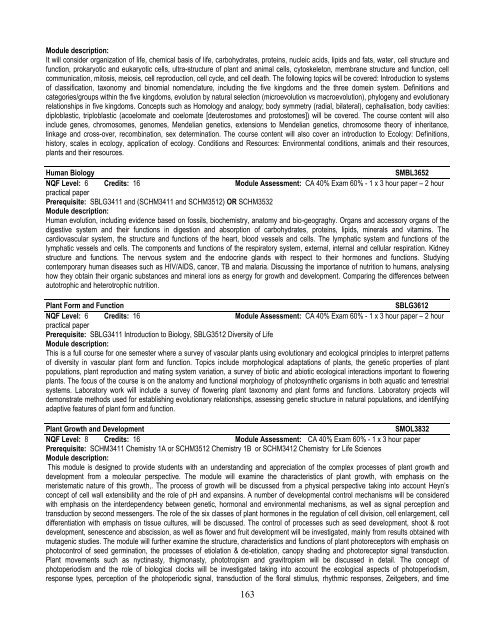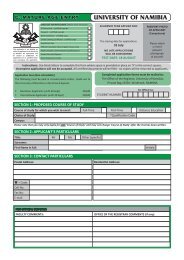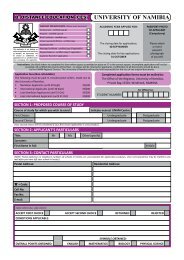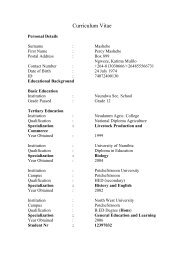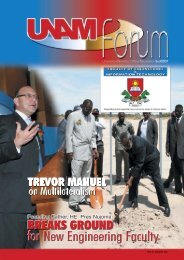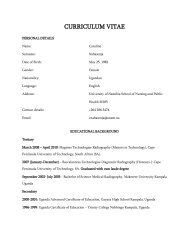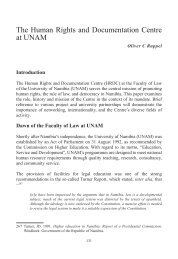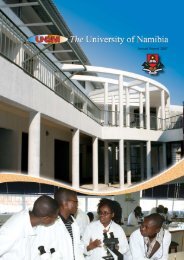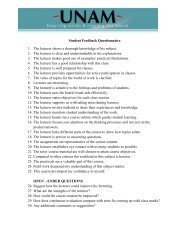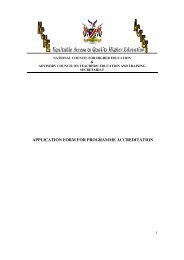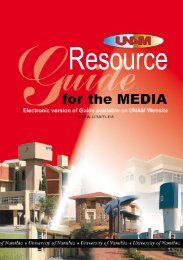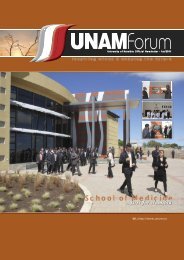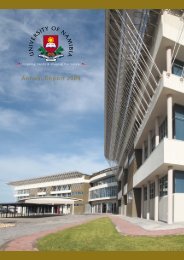UNIVERSITY OF NAMIBIA CENTRE FOR EXTERNAL STUDIES ...
UNIVERSITY OF NAMIBIA CENTRE FOR EXTERNAL STUDIES ...
UNIVERSITY OF NAMIBIA CENTRE FOR EXTERNAL STUDIES ...
You also want an ePaper? Increase the reach of your titles
YUMPU automatically turns print PDFs into web optimized ePapers that Google loves.
Module description:It will consider organization of life, chemical basis of life, carbohydrates, proteins, nucleic acids, lipids and fats, water, cell structure andfunction, prokaryotic and eukaryotic cells, ultra-structure of plant and animal cells, cytoskeleton, membrane structure and function, cellcommunication, mitosis, meiosis, cell reproduction, cell cycle, and cell death. The following topics will be covered: Introduction to systemsof classification, taxonomy and binomial nomenclature, including the five kingdoms and the three domein system. Definitions andcategories/groups within the five kingdoms, evolution by natural selection (microevolution vs macroevolution), phylogeny and evolutionaryrelationships in five kingdoms. Concepts such as Homology and analogy; body symmetry (radial, bilateral), cephalisation, body cavities:diploblastic, triploblastic (acoelomate and coelomate [deuterostomes and protostomes]) will be covered. The course content will alsoinclude genes, chromosomes, genomes, Mendelian genetics, extensions to Mendelian genetics, chromosome theory of inheritance,linkage and cross-over, recombination, sex determination. The course content will also cover an introduction to Ecology: Definitions,history, scales in ecology, application of ecology. Conditions and Resources: Environmental conditions, animals and their resources,plants and their resources.Human BiologySMBL3652NQF Level: 6 Credits: 16 Module Assessment: CA 40% Exam 60% - 1 x 3 hour paper – 2 hourpractical paperPrerequisite: SBLG3411 and (SCHM3411 and SCHM3512) OR SCHM3532Module description:Human evolution, including evidence based on fossils, biochemistry, anatomy and bio-geograghy. Organs and accessory organs of thedigestive system and their functions in digestion and absorption of carbohydrates, proteins, lipids, minerals and vitamins. Thecardiovascular system, the structure and functions of the heart, blood vessels and cells. The lymphatic system and functions of thelymphatic vessels and cells. The components and functions of the respiratory system, external, internal and cellular respiration. Kidneystructure and functions. The nervous system and the endocrine glands with respect to their hormones and functions. Studyingcontemporary human diseases such as HIV/AIDS, cancer, TB and malaria. Discussing the importance of nutrition to humans, analysinghow they obtain their organic substances and mineral ions as energy for growth and development. Comparing the differences betweenautotrophic and heterotrophic nutrition.Plant Form and FunctionSBLG3612NQF Level: 6 Credits: 16 Module Assessment: CA 40% Exam 60% - 1 x 3 hour paper – 2 hourpractical paperPrerequisite: SBLG3411 Introduction to Biology, SBLG3512 Diversity of LifeModule description:This is a full course for one semester where a survey of vascular plants using evolutionary and ecological principles to interpret patternsof diversity in vascular plant form and function. Topics include morphological adaptations of plants, the genetic properties of plantpopulations, plant reproduction and mating system variation, a survey of biotic and abiotic ecological interactions important to floweringplants. The focus of the course is on the anatomy and functional morphology of photosynthetic organisms in both aquatic and terrestrialsystems. Laboratory work will include a survey of flowering plant taxonomy and plant forms and functions. Laboratory projects willdemonstrate methods used for establishing evolutionary relationships, assessing genetic structure in natural populations, and identifyingadaptive features of plant form and function.Plant Growth and DevelopmentSMOL3832NQF Level: 8 Credits: 16 Module Assessment: CA 40% Exam 60% - 1 x 3 hour paperPrerequisite: SCHM3411 Chemistry 1A or SCHM3512 Chemistry 1B or SCHM3412 Chemistry for Life SciencesModule description:This module is designed to provide students with an understanding and appreciation of the complex processes of plant growth anddevelopment from a molecular perspective. The module will examine the characteristics of plant growth, with emphasis on themeristematic nature of this growth,. The process of growth will be discussed from a physical perspective taking into account Heyn’sconcept of cell wall extensibility and the role of pH and expansins. A number of developmental control mechanisms will be consideredwith emphasis on the interdependency between genetic, hormonal and environmental mechanisms, as well as signal perception andtransduction by second messengers. The role of the six classes of plant hormones in the regulation of cell division, cell enlargement, celldifferentiation with emphasis on tissue cultures, will be discussed. The control of processes such as seed development, shoot & rootdevelopment, senescence and abscission, as well as flower and fruit development will be investigated, mainly from results obtained withmutagenic studies. The module will further examine the structure, characteristics and functions of plant photoreceptors with emphasis onphotocontrol of seed germination, the processes of etiolation & de-etiolation, canopy shading and photoreceptor signal transduction.Plant movements such as nyctinasty, thigmonasty, phototropism and gravitropism will be discussed in detail. The concept ofphotoperiodism and the role of biological clocks will be investigated taking into account the ecological aspects of photoperiodism,response types, perception of the photoperiodic signal, transduction of the floral stimulus, rhythmic responses, Zeitgebers, and time163


